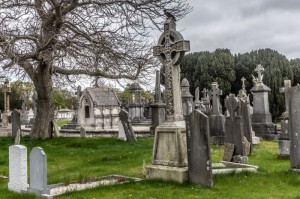LEARN MORE›››
Irish Burial Records
Gravestones were not always erected at the time of burial, particularly for poorer families. Perishable grave markers have long since disappeared. However, a successful and wealthy ancestor may have erected a memorial stone in memory of several generations of their family. This is also true of emigrant families, who returned to Ireland or sent money for a gravestone to be erected.
A grave may contain more than one family member and sometimes members of the extended family. This means that gravestone inscriptions and Irish burial records can open up all sorts of new lines of enquiry.
Databases of gravestone inscriptions are not a comprehensive source. In many cases the database consists of transcripts of gravestones that are still legible today, but not those that have fallen, broken or been weathered smooth. For many families a stone was never erected. However, if found, a gravestone inscription can detail several generations of a family, dates of birth and death and even, in some cases, occupations and addresses. There are numerous sources for gravestone inscriptions online.
Irish Burial Records – Gravestone Inscriptions
Brian Cantwell, who surveyed the graveyards of counties Wicklow, Wexford and South Dublin created the voluminous Memorials of the Dead which has been digitised and is available online at Findmypast (subscription). This site also holds a collection created by Ian Cantwell (son of Brian) of memorials of the dead for Galway and Mayo (check the map because this collection does not cover the entirety of both counties). It is possible to view the original transcript made by Cantwell, if relevant entries are found. This is a useful source for the many Church of Ireland families who settled in Wicklow and Wexford.
 Glasnevin Cemetery in Dublin has made their records available online. There is a free search facility, although you need an approximate date of burial and you will require credits to see more details of the burial. Read the extent of the records on the site carefully, because some links will identify other persons who were buried in the same grave, possibly identifying additional family members. Records at Glasnevin date from 1825. The burial registers for Deansgrange Cemetery in Dublin have been indexed and published online at www.rootsireland.ie up to about 1920. The burial records for Deansgrange and Shanganagh cemeteries up to the present have also been published online (free) by the Dun Laoghaire Rathdown County Council. Many other councils are also publishing burial registers online as original images or in databases, such as Fingal burial records and Waterford City and County Council and Limerck’s Mount Saint Lawrence Cemetery. Investigate the local council and city and county archives for the county or city you are researching for any collection of burial records that they have published or hold in their archives.
Glasnevin Cemetery in Dublin has made their records available online. There is a free search facility, although you need an approximate date of burial and you will require credits to see more details of the burial. Read the extent of the records on the site carefully, because some links will identify other persons who were buried in the same grave, possibly identifying additional family members. Records at Glasnevin date from 1825. The burial registers for Deansgrange Cemetery in Dublin have been indexed and published online at www.rootsireland.ie up to about 1920. The burial records for Deansgrange and Shanganagh cemeteries up to the present have also been published online (free) by the Dun Laoghaire Rathdown County Council. Many other councils are also publishing burial registers online as original images or in databases, such as Fingal burial records and Waterford City and County Council and Limerck’s Mount Saint Lawrence Cemetery. Investigate the local council and city and county archives for the county or city you are researching for any collection of burial records that they have published or hold in their archives.
History from Headstones is an online database of 50,000 inscriptions from over 800 graveyards in Northern Ireland. You will need to purchase credits in order use the search facility, but for Northern Irish ancestry, it may be worth investing in a small number of credits in order to use the search.
Dr. Jane Lyons website, From Ireland has a database of gravestone inscriptions from all over the country and the database details the origins of the transcript and links to photographs of the gravestones. You can also find listings of gravestone inscriptions at Irish Graves which is under expansion. The Irish Genealogy Project has also published numerous transcripts of headstones from graveyards all over the country.
Many local history societies and genealogy groups have transcribed and indexed gravestones in their area. A google search for the parish in which your ancestor may have been buried should turn up any links to gravestone transcriptions, if any have been published online.
Irish Burial Records – Burial Registers
Roman Catholic parish burial registers rarely survive for the 19th century, however, those that do may be found at Roots Ireland in their parish register collection or at the National Library of Ireland collection of digitised Irish parish registers. Burial registers are more common to Church of Ireland parishes and you can find these online at both www.rootsireland. ie and www.irishgenealogy.ie, but ONLY if they have been indexed and published. Remember to check the extent of the burial records that they have published to determine if there is anything actually relevant to your research.
There are numerous gravestone inscription projects that are publishing online collections specific to particular parishes or counties and it is worth searching for other, smaller collections, for relevant entries. Just be cautious regarding the accuracy of the published transcript and always try to find an image of the original stone for comparison.

